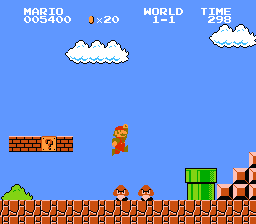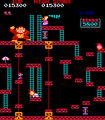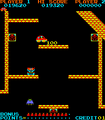Platform game facts for kids

A platform game, often called a platformer, is a type of video game. In these games, the main goal is to jump between different platforms. Players must control their character carefully to avoid falling or missing jumps. This kind of jumping and moving across obstacles is known as "platforming." If a game has jumping but the player doesn't control the jumps, like in The Legend of Zelda: Ocarina of Time, it's usually not called a platform game.
Platform games first appeared in the early 1980s as 2D games. Later, in the mid-1990s, 3D platformers became very popular. The name "platformer" comes from the fact that jumping on platforms is a huge part of how you play the game.
Contents
What Are Platform Games?
Platform games are all about movement and timing. You guide a character through a level filled with gaps, moving platforms, and enemies. The main challenge is to make precise jumps to reach new areas.
Players need good hand-eye coordination to succeed. If you miss a jump, your character might fall off the screen or into danger. This makes each jump feel important and exciting.
Core Gameplay of Platformers
The most important part of a platform game is the act of jumping. Players control when and how their character jumps. This control is key to navigating the game world.
You might need to jump over spikes, onto tiny ledges, or across wide chasms. Sometimes, platforms move, disappear, or even break. This adds to the challenge and fun.
How Did Platform Games Start?
Platform games have a rich history, starting with simple 2D graphics. Over time, they grew more complex and moved into the world of 3D.
Early 2D Platformers
The first platform games were in 2D. This means the characters and levels looked flat, like a cartoon. Early examples include Donkey Kong from 1981.
These early games often had a fixed screen or simple scrolling. They set the stage for many popular series that followed. They taught players the basic skills of jumping and timing.
The Rise of 3D Platformers
In the mid-1990s, games started to use 3D graphics. This changed platform games a lot. Instead of moving left and right, players could explore huge worlds in all directions.
Super Mario 64 (1996) is a famous example of a 3D platformer. It showed how much fun it could be to jump and explore in a three-dimensional space. This new style opened up many possibilities for game designers.
Different Kinds of Platform Games
Even though jumping is always important, platform games can be very different from each other. They often mix with other game types, creating unique experiences.
Mixing Genres in Platformers
Many platform games combine platforming with other styles of gameplay. For example, some platformers also include lots of fighting. In a game like Metroid, you jump and explore, but you also battle many enemies.
Other platformers might add puzzles or adventure elements. The key is that the jumping and platforming challenges remain a big part of the game. This makes the genre very flexible and exciting.
Modern Platform Game Styles
Today, platform games continue to evolve. Some modern platformers use realistic physics, making jumps feel more natural. Others focus on speed, challenging players to get through levels as fast as possible.
There are also "run-and-gun" platformers, where you jump and shoot at the same time. This shows how diverse the platform game genre has become since its beginnings.
Images for kids
-
This Donkey Kong (1981) level shows jumping between platforms, which is what platformers are all about.
-
Super Mario 64 (1996) replaced the straight paths of old platform games with huge worlds to explore.
-
Freedom Planet (2014) is a more traditional, retro-style platformer. It looks a lot like early Sonic the Hedgehog games with its pixel art.
See also
 In Spanish: Videojuego de plataformas para niños
In Spanish: Videojuego de plataformas para niños









